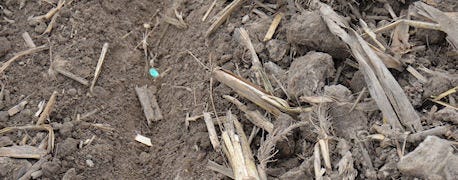
Normally Jeff Wise, Carroll County, can plant into corn ground that has been tilled once in the spring and once in the fall and have no problems getting uniform placement of seed in fields where he is planting corn after corn. That wasn't always the case this year, and it caused headaches in making decisions about how deep to plant the corn.
"The field made a large crop of corn last year and produced lots of stalk residue," notes Brock Gutwein, seed rep for Specialty Hybrids who helped counsel Wise on choosing seeding depths.
Related: Myths & Facts About Crop Residue Breakdown

Lots of stalks: Even after either one or two spring tillage trips, there was still lots of tough residue on the surface in this field. Sometimes it interfered with planting.
"Then the winter was so cold that it just doesn't seem like we got much decomposition of stalks over the winter. Even where fields were hit with a vertical tillage tool or some other form of tillage last fall, there was still big pieces of stalk coming up on the surface, instead of being decayed and worked into the soil," he says.
The dilemma was not putting seed too deep in areas where the planter didn't encounter residue, but deep enough that if the openers had trouble penetrating random residue, it didn't end up planting seed too shallow.
Wise had row cleaners on his planter, but they weren't always successful in moving all crop residue off the row area. "We just didn't get the breakdown of stalks we needed," he says. "There wasn't much disease last year and there were lots of stalks and big stalks, and it made for a lot more residue with our typical tillage operations than normal this spring."
Related: Handle Residue Piles Before You Till or Plant
He compensated in some cases by either running a vertical tillage tool over areas that were particularly heavy with residue as a second pre-tillage pass following a field cultivator, or running the field cultivator again. He believes it's a problem that developed due to a cold winter that didn't allow enough microbial breakdown of stalks. It may be an issue to address in the future.
Vertical tillage tools are designed to run fast and shallow, with the goal of cutting down on residue while leveling out the seedbed. Want to know more? Check out our free report 5 Tips You Need To Know About Vertical Tillage, for pointers on deciding if vertical tillage is right for you.
About the Author(s)
You May Also Like




